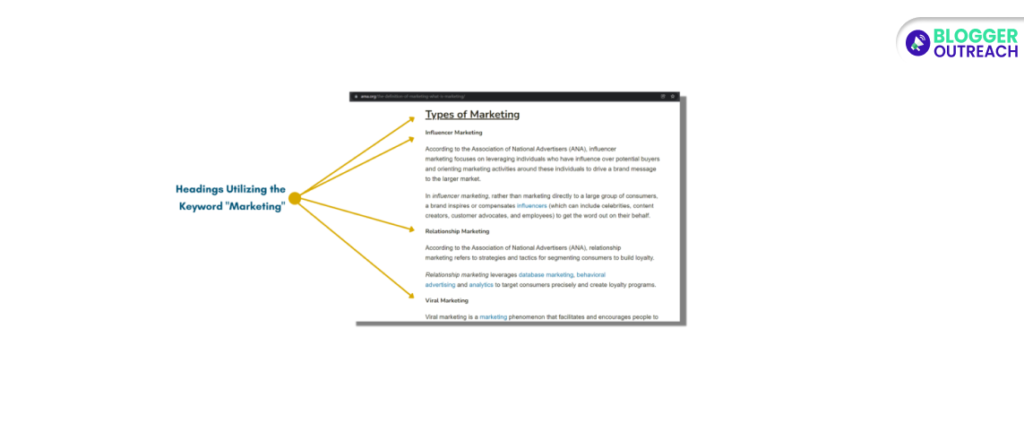Table Of Content
- 1 On Page SEO Checklist #1 – Identify Relevant Keywords For Your Content
- 2 On Page SEO Checklist #2 – Appropriate And Natural Keyword Placement Is The Key
- 3 On Page SEO Checklist #3 – There Is No Alternative High-Quality Content
- 4 On Page SEO Checklist #4 – Use Header Tags Appropriately
- 5 On-Page SEO Checklist #5 – Mobile Optimization
- 5.1 1. Choose A Mobile-Friendly Design
- 5.2 2. Optimize Page Load Speed
- 5.3 3. Use Mobile-Friendly Fonts And Text Sizes
- 5.4 4. Make Navigation Simple
- 5.5 5. Use Mobile-Optimized Images And Media
- 5.6 6. Implement Touch-Friendly Elements
- 5.7 7. Test Your Website On Multiple Devices
- 5.8 8. Check Mobile Compatibility With Google’s Mobile-Friendly Test
- 6 On Page SEO Checklist #6 – SEO-Optimized URL Structure
- 7 On Page SEO Checklist #7 – Optimize Your Meta Tags For Higher CTR
- 8 On Page SEO Checklist #8 – Image Optimization For On Page SEO
- 9 On Page SEO Checklist #9 – Robust Internal Linking Structure Is Important
- 10 On Page SEO Checklist #10 – Schema Markup
- 11 On Page SEO Checklist #11 – Add Social Sharing Buttons
- 12 Time To Take Action
Google search is all about user experience. Search engines’ prime goal is to elate their audience.
Be it content or website, on page SEO is the one-stop solution for that.
May SEOs come to us with slow speed, poor content, and unstructured sites. And then, they complain about unfavourable results – ranking, traffic, etc.
If you make the same mistake repeatedly, why are you expecting different results?
It’s time to change the way you approach on page SEO.
Our senior SEO experts have put all of their experience in this article. And they are pretty confident that this article comes with a wealth of knowledge.
They created an on-page SEO checklist with 11 actionable strategies and provided a detailed breakdown of each.
So, let’s begin!
On Page SEO Checklist #1 – Identify Relevant Keywords For Your Content

People search for keywords when they conduct a search. Research what words and phrases your target audience uses to search for information online. Here is the 5-step approach to Relevant Keywords:
1. Identify Your Niche
Clearly understand your website’s niche or topic before diving into keyword research tools. What are you offering, and who is your ideal audience? Once you have the clarity, decide your topic accordingly.
2. Brainstorm Focus Keywords
Start with a list of broad focus keywords related to your niche. These are the general terms that describe your content or products. Then, finalize the keyword aligning with your topic.
3. Use Keyword Research Tools
Leverage tools like Google Keyword Planner, Ahrefs, SEMrush, or Moz Keyword Explorer to expand your keyword list. These tools provide insights into search volume, competition, and related keywords.
4. Use Google Autocomplete
This feature gives you the phrases and questions from Google search. Here, you get the most common queries of a given topic.
5. Long-Tail Keywords
Don’t forget to include long-tail, more specific, and less competitive keywords. They often lead to higher conversion rates.
6. Analyze Competitors
Study your competitors’ content and keywords. This can reveal valuable insights and help you discover untapped opportunities.
On Page SEO Checklist #2 – Appropriate And Natural Keyword Placement Is The Key

First thing first, why does appropriate keyword placement matter? It makes sense for two reasons.
- Search Engine Visibility: Search engines like Google crawl your website to find relevant keywords. Your page is more likely to appear in search results when you place keywords appropriately.
- User Experience: Effective keyword placement satisfies search engines and enhances the user experience. Readers can quickly grasp the content’s main theme when keywords are naturally woven into the text.
How to Place Keywords Naturally and Effectively?
(i) In the Title: Start with your main keyword in the title. This tells both users and search engines what your content is focused on.
(ii) Within the first 100 Words: Introduce your primary keyword in the first 100 words. It sets the tone and provides immediate clarity.
(iii) Throughout the Content: Sprinkle related keywords and synonyms naturally throughout your content. Avoid keyword stuffing, as it can hurt your SEO efforts and make the content less enjoyable to read.
(iv) In Subheadings: Use keywords in subheadings (if applicable) to organize your content. This aids readers in navigating your page and reinforces the topic.
(v) In Image Alt Text: Don’t forget to include keywords in image alt text. This helps with image SEO and accessibility.
(vi) Within Hyperlinks: Anchor text for links on your website or external sources should incorporate relevant keywords. This provides context to the linked content.
On Page SEO Checklist #3 – There Is No Alternative High-Quality Content

People want answers to their problems. So, your content should directly speak to their pain points.
Hence, you get higher visibility and engagement.
Here’s a step-by-step guide on how to write quality content that ticks all the right on page SEO boxes:
1. Understand Your Audience
Start by comprehending your target audience’s needs and interests. What questions do they have? What problems can your content solve for them? Tailoring your content to your audience is the first step in quality content creation.
Next, go for keyword research and placement.
(Please Refer To The Above-Mentioned Sections)
2. Craft An Engaging Title
Your title is the first thing readers and search engines see. Make it compelling informative, and include your primary keyword naturally. Keep it concise – aim for clarity in around 10-13 words.
3. Write An Informative Introduction
In the opening paragraph, introduce your topic, and make sure your primary keyword appears naturally. Explain what readers can expect to learn or gain from your content. Keep sentences short for readability.
4. Create Well-Structured Content
Organize your content into sections with informative subheadings. This makes it easy for readers to scan and find relevant information. Incorporate keywords naturally within subheadings.
5. Focus on High-Quality Writing
Use clear, concise, and engaging language. Avoid buzzwords or jargon that might confuse your readers. Write in the second person (“you”) to connect directly with your audience.
6. Provide Value And Depth
Offer valuable insights, solutions, or information that go beyond the surface. In-depth content tends to perform better in search results. When relevant, back up your points with data, examples, and real-life experiences.
7. Maintain Proper Keyword Density
While keywords are crucial, avoid overusing them. Aim for a keyword density of around 1-2% to keep your content natural and avoid keyword stuffing.
8. Use High-Quality Visuals
Incorporate images, infographics, and videos where relevant. Ensure images are optimized for SEO by including descriptive alt text with keywords.
On Page SEO Checklist #4 – Use Header Tags Appropriately

Header tags are like the titles and subtitles of your content. They help both search engines and readers understand the hierarchy and organization of your information.
There are six levels of header tags, with <h1> being the highest and <h6> the lowest in importance.
1. Proper Use Of Header Tags
- <h1> (Heading 1): Use this for your page’s or article’s main title. It should contain your primary keyword and provide a clear overview of the content.
- <h2> (Heading 2): Subheadings under <h1>. Break your content into sections, and use <h2> tags for these subsections. Include relevant keywords when appropriate.
- <h3> to <h6> (Headings 3 to 6): These are used to subdivide content under <h2> headings further. Use them to create a logical and organized content structure.
2. Benefits Of Using Header Tags
Strive for improving readability. Header tags break up long blocks of text, making your content easier to read and skim. This benefits both your readers and search engines.
Place keywords organically. Including keywords in header tags helps search engines understand the content’s topic and relevance, potentially boosting your ranking.
Next, structure your Content. Header tags create a clear structure, guiding readers through your content and helping them find what they’re looking for.
3. Writing Effective Header Tags
Keep it concise and informative. Keep your header text short and to the point. Make sure it accurately summarizes the section’s content.
Place keywords naturally. Incorporate keywords naturally into your header tags. Don’t force them; instead, ensure they fit contextually.
Try to maintain consistency. Keep a consistent hierarchy. Use <h1> for the main title, <h2> for subsections, and so on. This creates an organized and user-friendly structure.
4. HTML Implementation
In your website’s HTML code, you’ll enclose header text within the appropriate tags,
like this:
Title</h1>
<h2>Subsection 1</h2>
<p>Your content here…</p>
<h2>Subsection 2</h2>
<p>More content…</p>
On-Page SEO Checklist #5 – Mobile Optimization

Mobile optimization is the key as most people access the internet via smartphones. Here’s a simple guide to make your website shine on mobile devices.
1. Choose A Mobile-Friendly Design
Select a responsive design for your website. This design adapts seamlessly to different screen sizes, ensuring your content looks great on desktop and mobile devices.
2. Optimize Page Load Speed
Fast-loading pages are crucial for mobile users. Compress images, enable browser caching, and minimize server response times to enhance your site’s speed.
3. Use Mobile-Friendly Fonts And Text Sizes
Ensure your text is easy to read on smaller screens. Use legible fonts and maintain a font size of at least 16px to enhance readability.
Keep your navigation menu clear and concise. Use a mobile-friendly menu design like the hamburger icon (three horizontal lines) to access menu items easily.
5. Use Mobile-Optimized Images And Media
Scale images appropriately for mobile devices and use the correct file formats (e.g., JPEG for photos PNG for graphics). Embed videos responsively to prevent distortion.
6. Implement Touch-Friendly Elements
Design buttons and links to be easily clickable with fingers on touch screens. Ensure there is enough space between clickable elements to prevent accidental taps.
7. Test Your Website On Multiple Devices
Regularly test your website on various mobile devices, including smartphones and tablets. This helps identify and fix any layout or functionality issues.
8. Check Mobile Compatibility With Google’s Mobile-Friendly Test
Use Google’s Mobile-Friendly Test tool to check your website’s performance on mobile devices. It provides insights and recommendations for improvement.
On Page SEO Checklist #6 – SEO-Optimized URL Structure

Concise search engines and users understand your content better. Here’s a step-by-step guide on how to ensure a on page SEO-friendly URL structure:
1. Keep It Short And Relevant
Your URL should be concise, typically under 13 words, and directly related to the content it represents. Avoid using long strings of numbers, special characters, or unnecessary words.
2. Use Keywords Naturally
Incorporate your primary keyword into the URL, ideally at the beginning. This provides a clear signal to search engines about your content’s topic. Keep it simple and avoid keyword stuffing.
3. Use Hyphens To Separate Words
When including multiple words in your URL, use hyphens to separate them. This enhances readability and helps search engines understand the word boundaries.
4. Avoid Special Characters And Spaces
Special characters, spaces, and symbols can cause URL readability and on page SEO issues. Stick to letters, numbers, and hyphens.
5. Use Lowercase Letters
URLs are case-sensitive, but using lowercase letters exclusively is a best practice for consistency and avoiding confusion.
6. Avoid URL Parameters (If possible)
URL parameters like “?id=123” can create duplicate content issues. If you can, opt for descriptive, static URLs instead.
7. Include Subfolders For Organization
Organize your content using subfolders when appropriate. For instance, if you have a blog, you could use “/blog/” before your post’s URL (e.g., https://www.bloggeroutreach.io/blog/permanent-backlinks/)
8. Be Mindful Of Dates
If your content includes dates, consider whether they’re necessary in the URL. They can make the URL longer and less evergreen. Use them only if they add value to the user.
On Page SEO Checklist #7 – Optimize Your Meta Tags For Higher CTR

Want more clicks on your website? Optimizing your meta tags can make a big difference. Here’s how:
1. Craft A Compelling Title Tag (Meta Title)
Your title tag is like the cover of a book – it should grab attention. Use your main keyword naturally, and make it enticing.
2. Use Descriptive Meta Descriptions
Your meta description should be a brief summary of what your page offers. Use action words and highlight benefits. In fact, Google’s advocate, John Muller, recently clarified that Meta Description has no specific word count. However, try to keep it concise.
3. Include Numbers And Symbols
Numbers and symbols (like “&,” “%” or “#”) can make your meta tags stand out. For example, “10 Proven Ways to Boost CTR.”
4. Create A Sense Of Urgency
Encourage clicks by adding a sense of urgency or FOMO (Fear of Missing Out). Phrases like “Limited Time Offer” or “Don’t Miss Out” can help.
5. Match Meta Tags To Content
Ensure that your meta tags accurately reflect your content. Misleading meta tags can lead to high bounce rates and reduced trust.
6. Use Rich Snippets (Schema Markup)
If applicable, use schema markup to enhance your meta tags. This can include star ratings, reviews, and other additional information, which can make your result more appealing.
On Page SEO Checklist #8 – Image Optimization For On Page SEO

Images can greatly enhance your web content, but they need optimization for on page SEO. Here’s how:
1. Use Descriptive Filenames
Rename image files to something relevant. Instead of “image123.jpg,” use “seo-optimization-tips.jpg.”
2. Choose the Right Image Format
For photos, use JPEG; for graphics, use PNG. These formats balance quality and size.
3. Resize Images Appropriately
Scale images to the needed dimensions. Don’t use a large image if a smaller one suffices.
Reduce (compress) file size without sacrificing quality. Online tools or image editing software can help.
4. Add Alt Text
The alt text describes the image and is crucial for accessibility and SEO. Keep it concise and descriptive.
5. Use Captions Wisely
Captions can provide context. Use them when relevant, but avoid overloading with keywords.
6. Optimize Image Placement
Place images near relevant text. They should complement your content.
7. Enable Lazy Loading
Lazy loading loads images as users scroll, reducing initial page load times.
8. Set Image Dimensions
Specify width and height attributes in HTML. This helps browsers render pages faster.
9. Create An Image Sitemap
Consider creating an image sitemap for large image collections to help search engines index them.
10. Use Image Compression Plugins
For content management systems like WordPress, use image compression plugins to automate optimization.
ShortPixel is a versatile plugin used for image optimization. It will allow you to:
Reduce the size of the file, speed up the site, and help to optimize images.
On Page SEO Checklist #9 – Robust Internal Linking Structure Is Important

Ensure a strong internal linking structure for On page SEO. Internal linking is like building pathways within your website to help both users and search engines navigate. Here’s how to keep it robust:
1. Plan Your Internal Links
Think strategically about where to place links within your content. Links should make sense and enhance the user experience.
2. Use Descriptive Anchor Text
When linking to another page on your site, use clear and descriptive anchor text. Avoid generic terms like “click here.”
3. Prioritize Relevant Pages
Link to pages that are contextually relevant to the content. This helps users find more information on related topics.
4. Use A Variety Of Anchor Text
Diversify your anchor text to avoid over-optimization. Use synonyms, variations, and related phrases.
Apart from the above practices, ensure the following:
- Don’t overcrowd your content with links. Use them judiciously, focusing on adding value.
- Regularly audit your website for broken internal links and fix them promptly.
- Consider creating hub pages that serve as central resources for specific topics. Link related articles to these hubs.
- Implement breadcrumb navigation for complex websites to help users and search engines understand site structure.
- Link to both your homepage and deeper pages. Distribute internal links throughout your site.
- Periodically review and update older content with new links to more recent articles or resources.
- Regularly assess your internal linking strategy’s effectiveness. Use tools like Google Analytics to track user behaviour.
- Organize related content into groups or silos. Ensure clear pathways between silos for easy navigation.
On Page SEO Checklist #10 – Schema Markup

Schema markup is like giving your web content a special language that search engines understand better. Here’s how to add it:
Determine which type of schema is appropriate for your content. Common types include “Article,” “Product,” “Event,” and more.
Next, use schema markup generators. You can use online schema markup generators to create the code. These tools make it easier to implement schema without coding skills.
Try to place a schema code. Once you have your schema markup code, insert it into the HTML of the page where it’s relevant. You can place it in the <head> section or within the content.
Try to validate your markup. Check the validity of your schema markup using Google’s Structured Data Testing Tool. This ensures there are no errors in your code.
Now, refer to schema.org for detailed documentation on how to use specific schema types. This helps you understand the available properties and how to use them effectively.
Focus on the most relevant information for the schema type you’re implementing. For example, for a “Recipe” schema, include details like ingredients, cooking time, and ratings.
If you have a local business, consider adding the “LocalBusiness” schema to provide essential information like address, phone number, and operating hours.
Use the “Event” schema to include details such as event name, date, location, and ticket information.
E-commerce websites should utilize the “Product” schema to highlight product details like price, availability, and reviews.
On Page SEO Checklist #11 – Add Social Sharing Buttons

Social sharing buttons make it easy for your readers to share your content on their social media profiles.
If someone shares your content, it gets exposed to a wider audience. Hence, you attract more traffic.
Importantly, when someone shares through these signal buttons….
…search engines consider your article worth reading.
Include buttons for popular social media platforms like Facebook, Twitter, LinkedIn, and Pinterest.
Please ensure the buttons are mobile-friendly for users on smartphones and tablets. Many plugins customize button design and placement to match your website’s style.
Don’t clutter your pages with too many sharing buttons; focus on the most relevant platforms.
Time To Take Action
Do you like this On-page SEO checklist? Knowledge is of NO use if you do not apply it.
Now that you know these 11 steps, it’s time to implement them. So, start taking action. You can not implement everything together, go one by one.
While implementing, if you face any difficulties, feel free to reach out to us.
Would you like an Off-page SEO checklist like this? If yes, then let us know.
Read Also:








